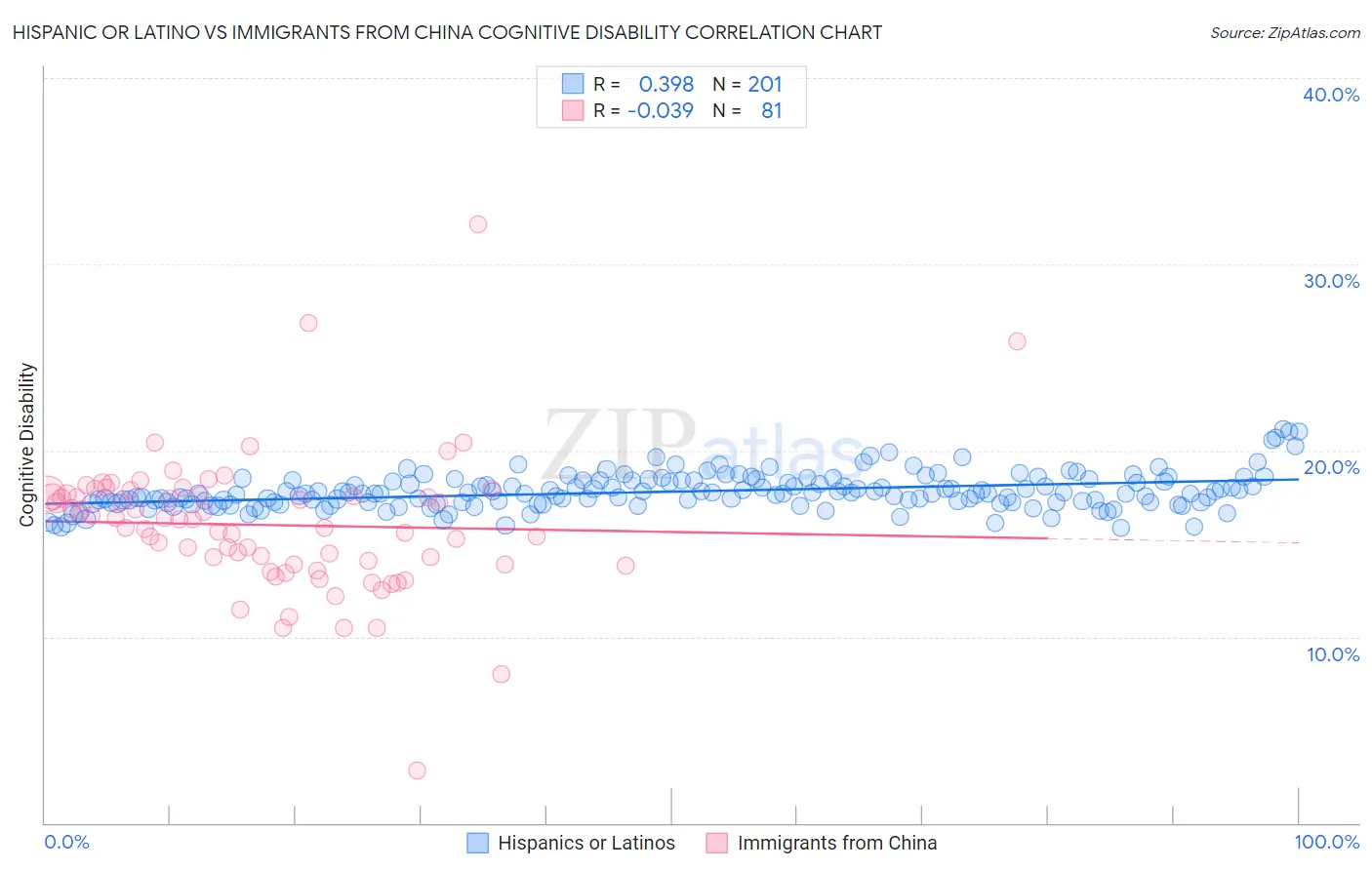Hispanic or Latino vs Immigrants from China Cognitive Disability
COMPARE
Hispanic or Latino
Immigrants from China
Cognitive Disability
Cognitive Disability Comparison
Hispanics or Latinos
Immigrants from China
17.9%
COGNITIVE DISABILITY
0.6/ 100
METRIC RATING
254th/ 347
METRIC RANK
16.9%
COGNITIVE DISABILITY
94.9/ 100
METRIC RATING
121st/ 347
METRIC RANK
Hispanic or Latino vs Immigrants from China Cognitive Disability Correlation Chart
The statistical analysis conducted on geographies consisting of 578,401,671 people shows a mild positive correlation between the proportion of Hispanics or Latinos and percentage of population with cognitive disability in the United States with a correlation coefficient (R) of 0.398 and weighted average of 17.9%. Similarly, the statistical analysis conducted on geographies consisting of 457,042,790 people shows no correlation between the proportion of Immigrants from China and percentage of population with cognitive disability in the United States with a correlation coefficient (R) of -0.039 and weighted average of 16.9%, a difference of 5.8%.

Cognitive Disability Correlation Summary
| Measurement | Hispanic or Latino | Immigrants from China |
| Minimum | 15.8% | 2.8% |
| Maximum | 21.1% | 32.2% |
| Range | 5.3% | 29.4% |
| Mean | 17.8% | 16.0% |
| Median | 17.7% | 16.3% |
| Interquartile 25% (IQ1) | 17.2% | 13.9% |
| Interquartile 75% (IQ3) | 18.4% | 17.7% |
| Interquartile Range (IQR) | 1.2% | 3.8% |
| Standard Deviation (Sample) | 0.96% | 3.8% |
| Standard Deviation (Population) | 0.96% | 3.8% |
Similar Demographics by Cognitive Disability
Demographics Similar to Hispanics or Latinos by Cognitive Disability
In terms of cognitive disability, the demographic groups most similar to Hispanics or Latinos are Hopi (17.9%, a difference of 0.0%), Immigrants from the Azores (17.9%, a difference of 0.0%), Bahamian (17.9%, a difference of 0.010%), Immigrants from Grenada (17.9%, a difference of 0.020%), and Cree (17.9%, a difference of 0.030%).
| Demographics | Rating | Rank | Cognitive Disability |
| Samoans | 0.7 /100 | #247 | Tragic 17.9% |
| French American Indians | 0.7 /100 | #248 | Tragic 17.9% |
| Cree | 0.7 /100 | #249 | Tragic 17.9% |
| Immigrants | Ethiopia | 0.7 /100 | #250 | Tragic 17.9% |
| Malaysians | 0.6 /100 | #251 | Tragic 17.9% |
| Immigrants | Grenada | 0.6 /100 | #252 | Tragic 17.9% |
| Hopi | 0.6 /100 | #253 | Tragic 17.9% |
| Hispanics or Latinos | 0.6 /100 | #254 | Tragic 17.9% |
| Immigrants | Azores | 0.6 /100 | #255 | Tragic 17.9% |
| Bahamians | 0.6 /100 | #256 | Tragic 17.9% |
| Mexican American Indians | 0.6 /100 | #257 | Tragic 17.9% |
| Immigrants | Armenia | 0.6 /100 | #258 | Tragic 17.9% |
| Ethiopians | 0.5 /100 | #259 | Tragic 17.9% |
| Immigrants | Belize | 0.5 /100 | #260 | Tragic 17.9% |
| Guamanians/Chamorros | 0.5 /100 | #261 | Tragic 17.9% |
Demographics Similar to Immigrants from China by Cognitive Disability
In terms of cognitive disability, the demographic groups most similar to Immigrants from China are Scottish (16.9%, a difference of 0.020%), Immigrants from Western Europe (16.9%, a difference of 0.020%), Portuguese (16.9%, a difference of 0.030%), Turkish (16.9%, a difference of 0.050%), and South African (16.9%, a difference of 0.10%).
| Demographics | Rating | Rank | Cognitive Disability |
| Koreans | 97.1 /100 | #114 | Exceptional 16.8% |
| Yup'ik | 96.9 /100 | #115 | Exceptional 16.9% |
| Inupiat | 96.5 /100 | #116 | Exceptional 16.9% |
| Immigrants | Japan | 96.2 /100 | #117 | Exceptional 16.9% |
| Immigrants | Denmark | 96.2 /100 | #118 | Exceptional 16.9% |
| South Africans | 95.5 /100 | #119 | Exceptional 16.9% |
| Scottish | 95.0 /100 | #120 | Exceptional 16.9% |
| Immigrants | China | 94.9 /100 | #121 | Exceptional 16.9% |
| Immigrants | Western Europe | 94.8 /100 | #122 | Exceptional 16.9% |
| Portuguese | 94.7 /100 | #123 | Exceptional 16.9% |
| Turks | 94.5 /100 | #124 | Exceptional 16.9% |
| Scandinavians | 94.1 /100 | #125 | Exceptional 16.9% |
| Europeans | 93.4 /100 | #126 | Exceptional 17.0% |
| Immigrants | Costa Rica | 93.1 /100 | #127 | Exceptional 17.0% |
| Nicaraguans | 93.0 /100 | #128 | Exceptional 17.0% |